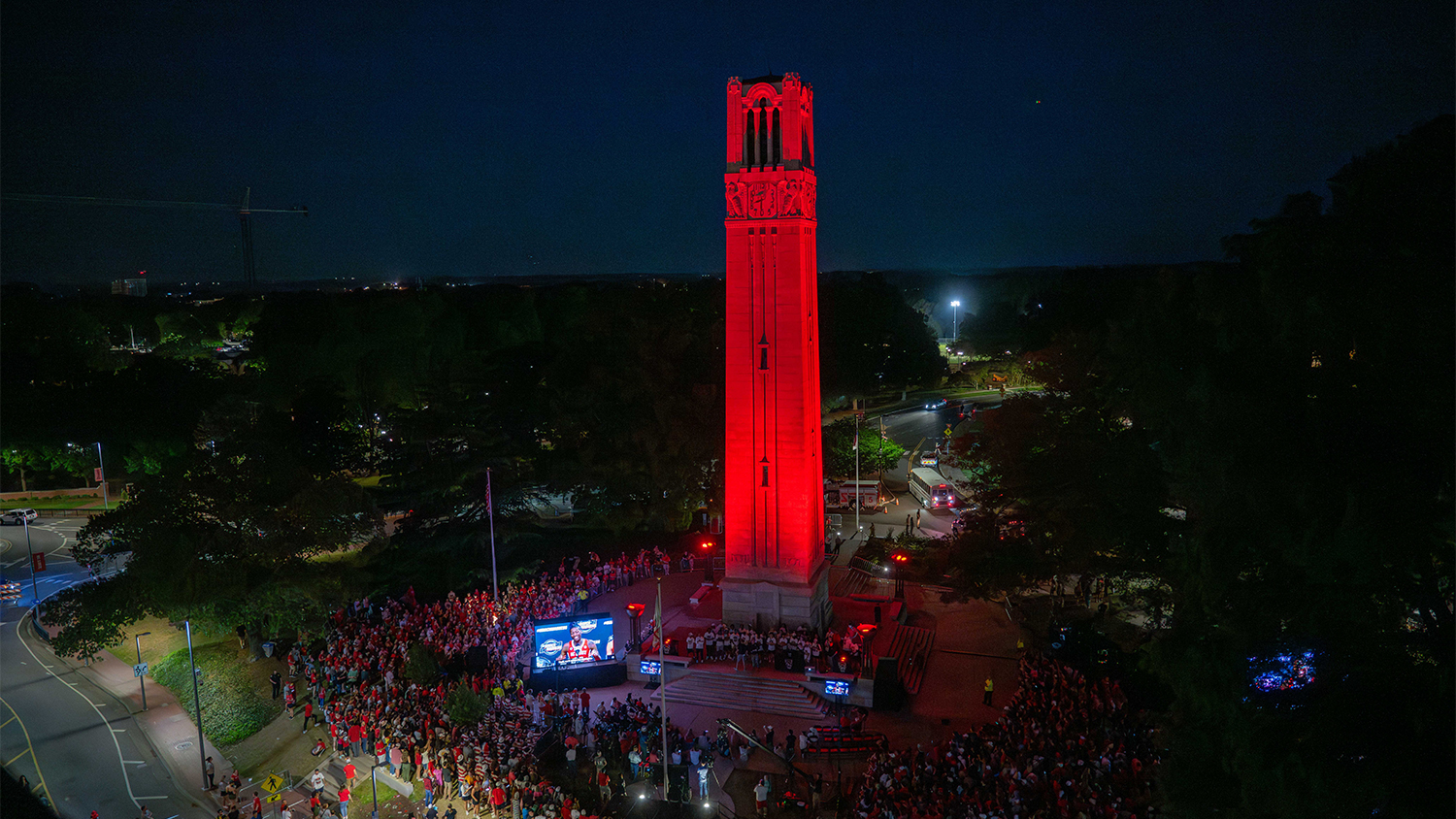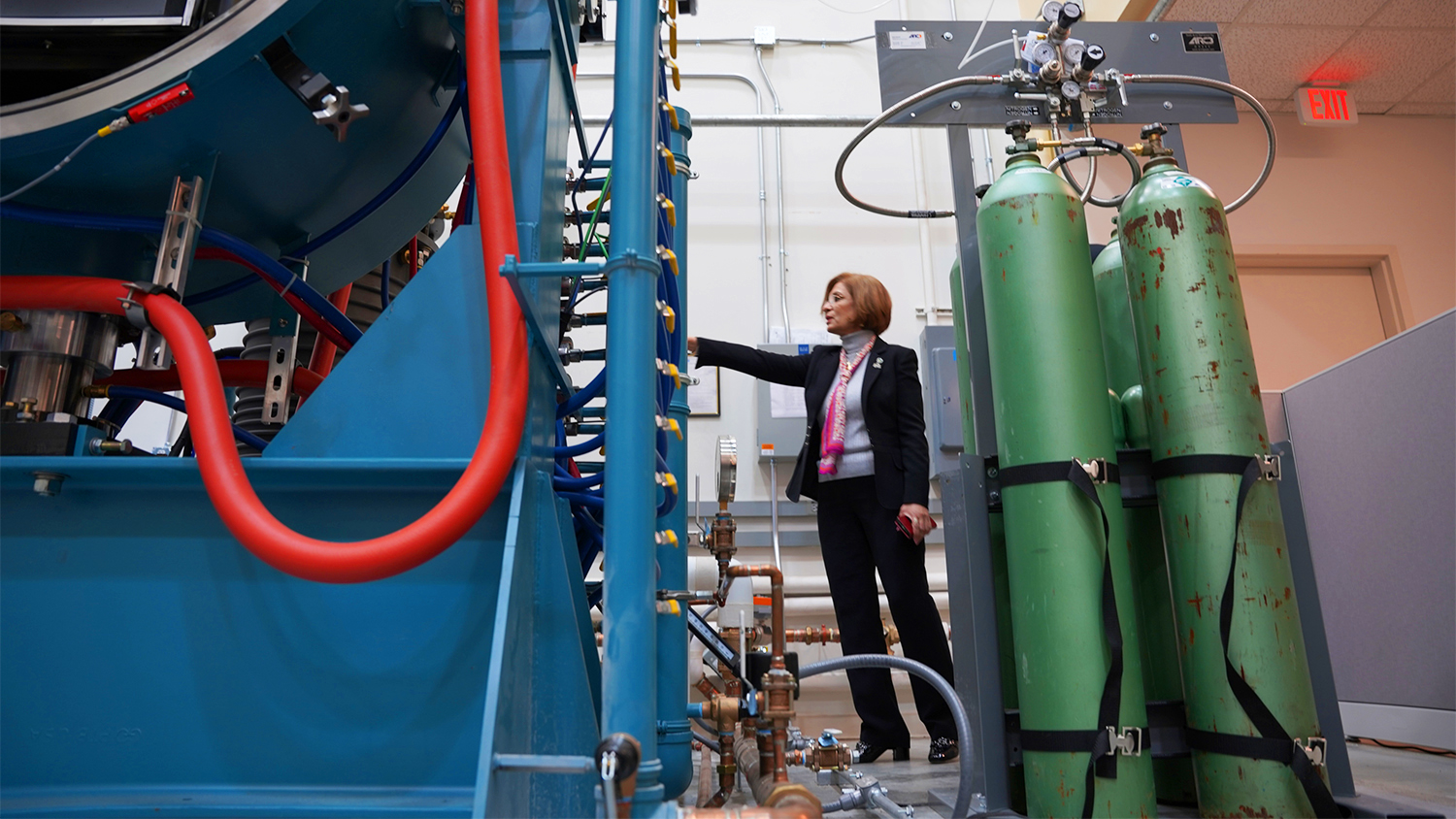Power Station

 The International Energy Agency’s 2015 World Energy Outlook estimates that mankind’s appetite for electricity will increase by more than 70 percent between now and 2040 as the global population grows and advances in developing countries mean more demand for power.
The International Energy Agency’s 2015 World Energy Outlook estimates that mankind’s appetite for electricity will increase by more than 70 percent between now and 2040 as the global population grows and advances in developing countries mean more demand for power.
Making more efficient use of energy goes hand in hand with the development of new resources as the global community wrestles with how to meet this demand.
President Barack Obama came to NC State in January 2014 to announce that the university would lead the Next Generation Power Electronics Manufacturing Innovation Institute tasked with furthering development and manufacturing of wide bandgap (WBG) semiconductor-based power electronics.
The institute, now called PowerAmerica, has already helped U.S. companies bring new products to market and is spurring the development of new technologies on NC State’s Centennial Campus. And that’s only in the institute’s first year of existence.
This ambitious project funded by the Department of Energy’s Advanced Manufacturing Office brings together academia, industry and government to create solutions that close the gap between energy demand and resources while helping to stem the tide of advanced manufacturing leaving the United States for other countries. That’s not to mention providing the College of Engineering, and the university as a whole, with new educational and research opportunities while changing the national conversation about energy and our renewable future.
 The National Network for Manufacturing Innovation concept is a new effort for the 21st century and is a national investment in strategic technologies to improve U.S. economic competitiveness. But the idea behind it, that the public and private sectors can work together to spur innovation, is not.
The National Network for Manufacturing Innovation concept is a new effort for the 21st century and is a national investment in strategic technologies to improve U.S. economic competitiveness. But the idea behind it, that the public and private sectors can work together to spur innovation, is not.
Retired Army Major Gen. Nick Justice, PowerAmerica’s executive director, points to the land-grant college program that led to the founding of several public research universities in the United States in the 19th century as one previous example.
“Trying to shape and lead and bring connections between industry and government and academia is really what the focus of these institutes is, and if you look back at the history of the land grant colleges, I would say that’s the model that the institutes take on today,” he said.
Established as a land grant college in 1887, NC State has carried on that tradition with its innovative Centennial Campus, where industry, government and academics work side by side to bring about solutions for the challenges facing humanity in the 21st century. Add to that the College’s long history of innovation in the semiconductor field and its lead role in a National Science Foundation (NSF) Engineering Research Center that is building a smarter power grid and it’s no surprise that the University was tapped as the home for PowerAmerica.
Smaller, Faster, More Reliable and More Efficient
 WBG semiconductors switch faster and can operate at higher temperatures and voltages than the silicon semiconductors that have been widely used for the last 50 years. That technological leap forward will help the next generation of everything from consumer electronics, electric vehicles and electric motors to data centers and renewable energy applications like wind turbines and solar arrays to be smaller, faster, more reliable and more efficient.
WBG semiconductors switch faster and can operate at higher temperatures and voltages than the silicon semiconductors that have been widely used for the last 50 years. That technological leap forward will help the next generation of everything from consumer electronics, electric vehicles and electric motors to data centers and renewable energy applications like wind turbines and solar arrays to be smaller, faster, more reliable and more efficient.
But because it’s a fairly new technology and engineers across the country are just starting to learn how to put it into commercial applications, PowerAmerica’s aim is to help reduce the barriers to commercial adoption. The institute will do that by funding a mix of more than 25 industry and university projects per year that will lower the cost of WBG power devices and demonstrate the size, weight and power efficiency advantages of WBG power electronics in commercial applications. As the institute’s collaborations with industry grow, new connections will be made leading to new manufacturing facilities and research collaborations that will also improve the U.S. supply chain for WBG power electronics.
 “Ultimately, this technology will end up being inherently more reliable than silicon,” said Dr. John Muth, PowerAmerica’s deputy director and a professor in the Department of Electrical and Computer Engineering. “Silicon has been around for many years, but with these wide bandgap semiconductors we will significantly improve power electronics and will be able to cut the power losses in many systems by about half.”
“Ultimately, this technology will end up being inherently more reliable than silicon,” said Dr. John Muth, PowerAmerica’s deputy director and a professor in the Department of Electrical and Computer Engineering. “Silicon has been around for many years, but with these wide bandgap semiconductors we will significantly improve power electronics and will be able to cut the power losses in many systems by about half.”
The institute is spending more than $30 million in its first year, with 75 percent going to partners outside NC State and half of that money being supplied by industry and other cost matching.
 By March 2015, industry partner Arkansas Power Electronics International (APEI) released a new generation of power modules that contain WBG semiconductors with the institute’s help. The new product is expected to be widely used because of its very low inductance and superior thermal properties. By May, APEI, which is now part of CREE spinoff Wolfspeed, had released a second product.
By March 2015, industry partner Arkansas Power Electronics International (APEI) released a new generation of power modules that contain WBG semiconductors with the institute’s help. The new product is expected to be widely used because of its very low inductance and superior thermal properties. By May, APEI, which is now part of CREE spinoff Wolfspeed, had released a second product.
“Our purpose is to accelerate the new products,” Muth said. “We’re assisting them in being able to move faster and to increase their opportunities in the international marketplace.”
Institute leaders anticipate a cluster of companies that will partner with and support PowerAmerica growing in the Research Triangle area, similar to the way in which a cluster of clean technology companies has interacted with the NSF Future Renewable Electric Energy Delivery and Management (FREEDM) Systems Center, also led by NC State and based on Centennial Campus.
The institute has plans for a power electronics assembly and teaching manufacturing laboratory in the Varsity Research Building on Centennial Campus that would provide opportunities not only for NC State students and researchers but also for industry.
Entrepreneurs and small companies with a need to produce small batches of a circuit board for a new product often run into problems finding a contract manufacturer willing to work at low volumes, Muth said. This line could help solve that problem and would keep the work in this country instead of China or somewhere else overseas.
“To get them from initial hand-built prototype to something that’s manufacturable, the teaching manufacturing laboratory would greatly aid that transition,” Muth said. “We can aid in the design and will have better tools for them to build their initial prototypes but then we can also show them what they would need to do to make their prototypes manufacturable at higher volumes.“
Statewide Benefit
Dr. Srdjan Lukic is an associate professor in the Department of Electrical and Computer Engineering who is associated with both PowerAmerica and the FREEDM Center. As part of his FREEDM research, Lukic has imagined a wireless charging system for electric vehicles (EV) that would involve several modules stationed along a highway that would charge the battery in an EV as it cruised by.
Now, with support from PowerAmerica, he is working on an EV fast charger that, because it uses WBG semiconductors, is 10 times smaller than current EV charging stations. These smaller chargers — which also don’t require a low-frequency step-down transformer to convert power from a utility line to a lower voltage and are thus much smaller and easier to install — could one day be installed anywhere along a power network, including at gas stations or homes.
FREEDM, like the NSF Nanosystems Engineering Research Center for Advanced Self-Powered Systems of Integrated Sensors and Technologies (ASSIST) that is developing self-powered and wearable health monitoring systems and is also led by NC State, has offered transformative research and educational opportunities for faculty members and students. PowerAmerica will do the same with similar summer programs for undergraduates, community college instructors and high school teachers but will be unique nationally by offering a teaching manufacturing laboratory.
The laboratory will have an emphasis on teaching design for manufacturing, design for reliability and design for cost. This will give NC State students a competitive advantage over their peers who learn these design for “X” principles on the job when they join industry and start manufacturing products.
As NC State students and faculty members benefit, so too will the state as a whole. As a land grant university, NC State has a long tradition of improving the lives of North Carolinians by educating their sons and daughters and transferring that knowledge into a stronger, more prosperous state.
This will only continue with PowerAmerica, Justice said.
“The things that this university produces — students number one but research and the technologies number two — are going to be a vibrant part of growing the state’s economic future.”
Return to contents or download the Spring/Summer 2016 NC State Engineering magazine (PDF, 3MB).
- Categories:


